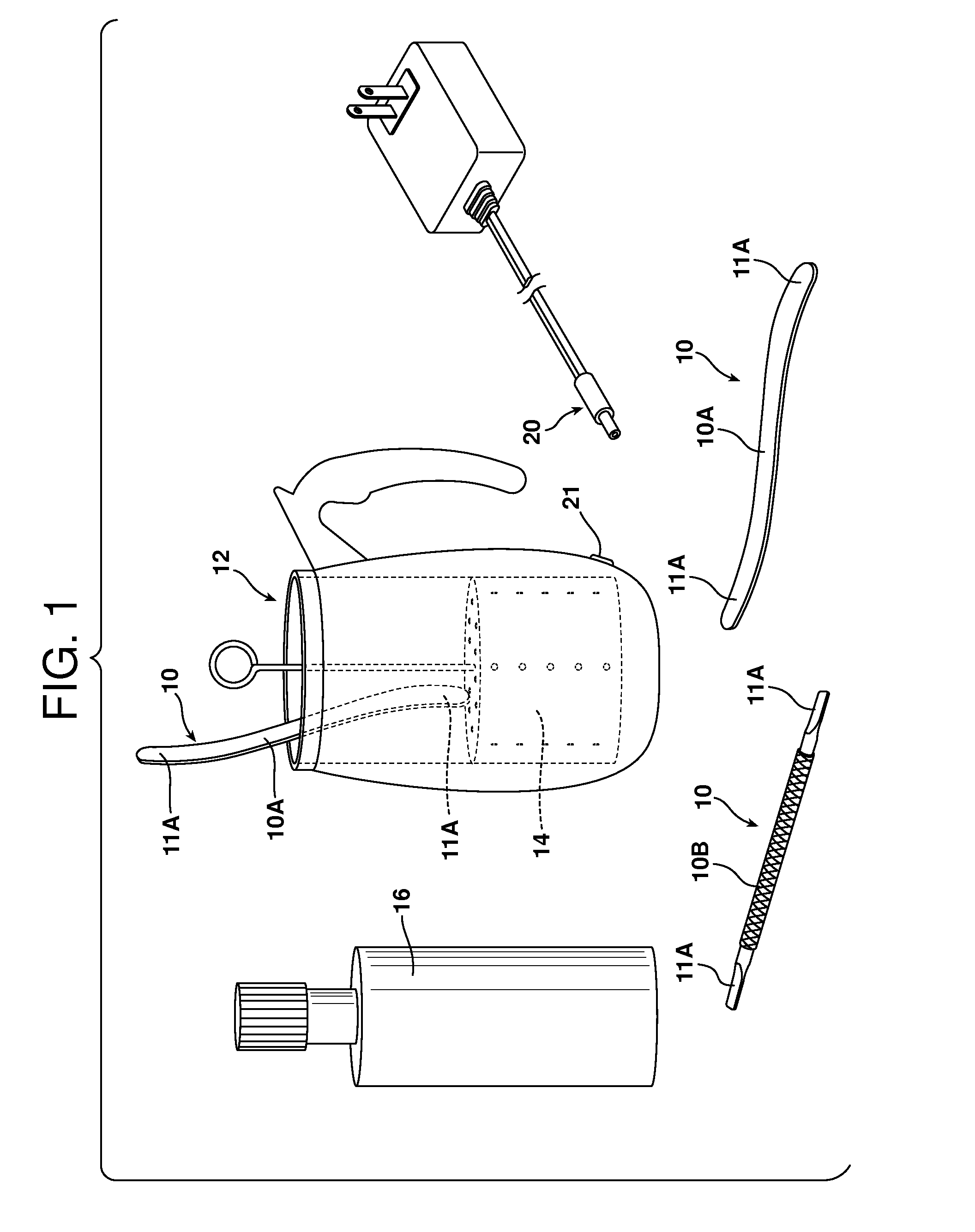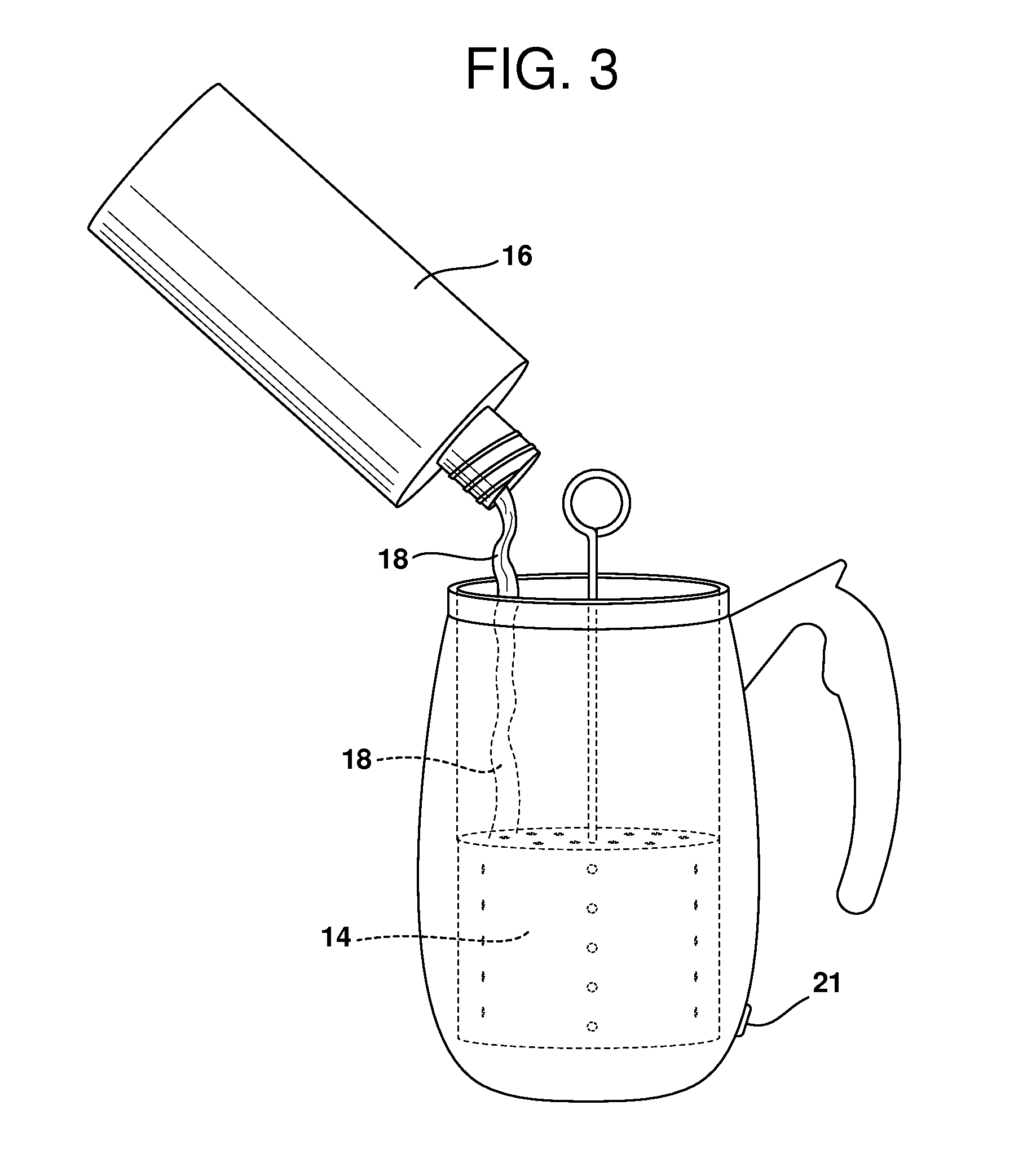Compositions for cleaning applicators for hair removal compositions
a technology of compositions and cleaning applicators, applied in the direction of detergent compounding agents, aerosol delivery, hair cosmetics, etc., can solve the problems of degrading hair, degrading hair, and generally painful and uncomfortable waxing for the person undergoing wax treatment, so as to achieve safe cleaning and sterilization
- Summary
- Abstract
- Description
- Claims
- Application Information
AI Technical Summary
Benefits of technology
Problems solved by technology
Method used
Image
Examples
example 1
Cleaning Composition Ingredients
[0121]
1. Highly refined white mineral oil (Sonneborn97.7% by weight. Blandol)2. Triclosan (CAS Number 3380-34-5, Chem / UPAC0.3% by weight.name description 5-Chloro-2-(2,4-dichlorophenoxy)phenol)3. Microbial Control Neolone ® PH 1001.0% by weight.(Dow Chemical) (Phenoxyethanol C.A.S.Reg. No. 122-99-6)4. Fragrance / Preservative (Phenoxy Ethanol,1.0% by weight 1,2Hexanediol, Decylene Glycol)SymriseSymocide ® PS)
Procedure:
[0122]At room temperature the triclosan is dispersed and dissolved into the fragrance for solubility. When completely mixed the Phenoexyethanol is dispersed into the mixture. Then this mixture is dispersed at room temperature into the Mineral oil while stirring. Continue stirring for 30 minutes.
[0123]The end product appears slightly opaque (milky white) until heated in the heater cup 12 to 125° F., at which time it becomes clear.
[0124]The following methods were used in the preparation and testing of the antibacterial ...
example 2
S. aureus ATCC 6538
Experimental Design:
Time Kill Study Using 1 Part Inoculum: 9 Parts Test Product, a Modification of ASTM Method E2315.
The following test organisms are used:
1) S. aureus ATCC 6538
[0131]0.09 ml of SS applicator cleaner warmed to 52° C. are mixed with 0.01 ml of a culture diluted-10−1 (prepared from an overnight culture (approx 22 hours old) diluted to 0.45 OD at 600 nm), and mixed for 15 seconds. After the time has elapsed, 4.9 ml of DIE broth is added to the reaction tube to quench antimicrobial the activity. A secondary 1:100 dilution with D / E broth (0.02 ml:1.98 ml D / E broth) and tertiary dilution 1:5 (0.2 ml:0.8 ml D / E broth) is carried out and aliquots of 0.5 ml of the last two dilutions are plated. The TSA plates are incubated for 24-48 hours at 35° C. to 37° C. As a control, 0.09 ml of drug-free mineral oil is substituted for the test product and processed in the same manner as the test groups. A saline+D / E broth uninoculated blank is also subc...
example 3
S. aureus ATCC 6538
Experimental Design:
Time Kill Study Using 1 Part Inoculum: 9 Parts Test Product, a Modification of ASTM Method E2315.
The following test organisms are used:
1) S. aureus ATCC 6538
Note: inoculum is increased 10× compared to previous experiment to determine if the percentage reduction is antibacterial (≧99.9%)
[0139]0.09 ml of Cleaning Composition warmed to 52° C. are mixed with 0.01 ml of an overnight culture diluted to 0.45 OD at 600 nm), and mixed for 15 seconds. After the time has elapsed, 4.9 ml of DIE broth is added to the reaction tube to quench antimicrobial the activity. A secondary 1:100 dilution with D / E broth (0.02 ml:1.98 ml D / E broth) and 0.5 ml aliquots of the last dilution are plated. The TSA plates are incubated for 24-48 hours at 35° C. to 37° C. As a control, 0.09 ml of drug-free mineral oil is substituted for the test product and processed in the same manner as the test groups with an extra 1:10 dilution of which, a 0.5 ml aliquot is...
PUM
| Property | Measurement | Unit |
|---|---|---|
| temperature | aaaaa | aaaaa |
| temperatures | aaaaa | aaaaa |
| temperatures | aaaaa | aaaaa |
Abstract
Description
Claims
Application Information
 Login to View More
Login to View More - R&D
- Intellectual Property
- Life Sciences
- Materials
- Tech Scout
- Unparalleled Data Quality
- Higher Quality Content
- 60% Fewer Hallucinations
Browse by: Latest US Patents, China's latest patents, Technical Efficacy Thesaurus, Application Domain, Technology Topic, Popular Technical Reports.
© 2025 PatSnap. All rights reserved.Legal|Privacy policy|Modern Slavery Act Transparency Statement|Sitemap|About US| Contact US: help@patsnap.com



